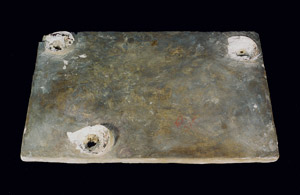 The horse was a popular subject during the Tang Dynasty; here it is shown standing with one front leg raised and it rests on a rectangular base. It was probably a funerary object.
The horse was a popular subject during the Tang Dynasty; here it is shown standing with one front leg raised and it rests on a rectangular base. It was probably a funerary object.
The terracotta is a calcareous clay fired at a low temperature, it has surface traces of red pigment, the remains of the old cold-painted decoration.
The figure was fragmented and bore traces of interventions dating from different periods.
The oldest concerned the base - a complete reconstruction carried out with a straw and plaster mixture and in an extremely precarious condition due to a series of cracks that crossed from one side to the other.
The most recent intervention was carried out to join the hocks and two hooves with metal pins, fixed by resinous substances, that were rusty and distorted.
Given the precarious condition of the base a replacement was thought of, but it was considered more appropriate to keep the old restoration as it was still functional and formed part of the object's history.
So the base was cleaned and consolidated by injecting Primal E 330 S acrylic resin in a solution of 50% water, 40% chetone, 10% Primal into the micro-cracks. The base bottom was then reinforced by applying a thin piece of cloth lining, soaked in a mixture of plaster and Primal AC 33 acrylic resin.
In order to give more stability to the artefact, the restored base was then supported by a 8mm thick layer of plexiglass that is 2cm larger than the base perimeter and glued with three dabs of transparent non-acetic silicone.
As the removal of the pins could have jeopardised the whole work, they have been retained: rust was removed from the salvaged pins which were then sealed with acrylic resin whilst the others were replaced by fibreglass pins.
 Before welding the fragments together with two-component epoxy resins, a layer of 5% solution of Paraloid B72 in acetone was brushed on the fractures to ensure the reversibility of the operation.
Before welding the fragments together with two-component epoxy resins, a layer of 5% solution of Paraloid B72 in acetone was brushed on the fractures to ensure the reversibility of the operation.
Missing parts were reintegrated by choosing a slightly toned down colour compared to the dominant hue of the original ceramic material.